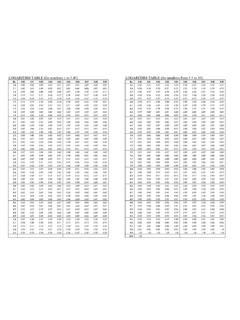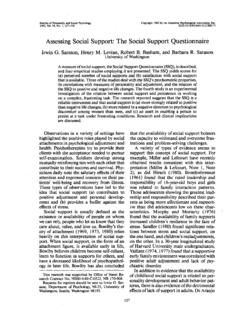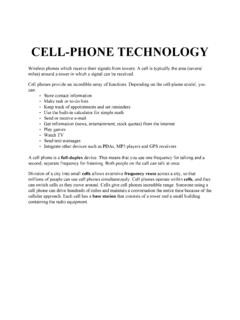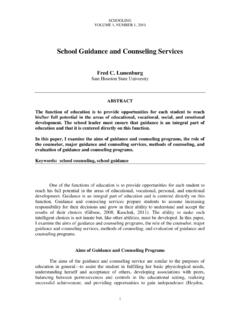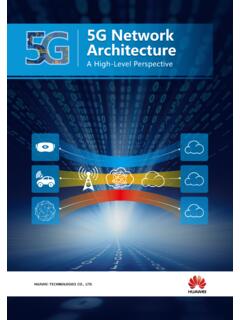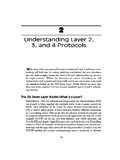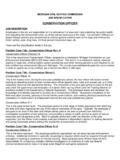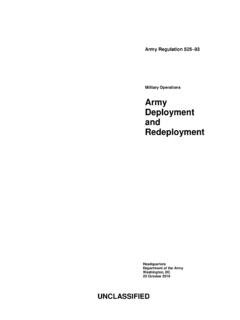Transcription of CELL-PHONE TECHNOLOGY - WikiEducator
1 CELL-PHONE TECHNOLOGYW ireless phones which receive their signals from towers. A cell is typically the area (severalmiles) around a tower in which a signal can be phones provide an incredible array of functions. Depending on the CELL-PHONE model, youcan: Store contact information Make task or to-do lists Keep track of appointments and set reminders Use the built-in calculator for simple math Send or receivee-mail Get information (news, entertainment, stock quotes) from the internet Play games Watch TV Send text messages Integrate other devices such as PDAs, MP3 players and GPS receiversA cell phone is afull-duplexdevice. That means that you use one frequency for talking and asecond, separate frequency for listening. Both people on the call can talk at of a city into smallcellsallows extensivefrequency reuseacross a city, so thatmillions of people can use cell phones phones operate withincells, and theycan switch cells as they move around.
2 Cells give cell phones incredible range. Someone using acell phone can drive hundreds of miles and maintain a conversation the entire time because of thecellular cell has abase stationthat consists of a tower and a small buildingcontaining the radio single cell in an analog CELL-PHONE system uses one-seventh of the available duplex voicechannels. That is, each cell is using one-seventh of the available channels so it has a unique set offrequencies and there are no collisions: A CELL-PHONE carrier typically gets832 radio frequenciesto use in a city. Each cell phone uses two frequencies per call -- a duplex channel -- so there are typically395 voice channelsper carrier. (The other 42 frequencies are used for control channels)Therefore, each cell has about56 voice channelsavailable. In other words, in any cell, 56 peoplecan be talking on their cell phone at one time.
3 Analog cellular systems are consideredfirst-generation mobile TECHNOLOGY , or1G. With digital transmission methods (2G), the numberof available channels increases. For example, aTDMA-baseddigital system (more on TDMA later) can carry three times as many calls as an analog system, so each cell has about 168channels phones havelow-power transmittersin them. Many cell phones have two signal watts and 3 watts. The base station is also transmitting at low power. Low-power transmittershave two advantages: Thetransmissionsof a base station and the phones within its cell do not make it veryfar outside that cell. Therefore, 2 different cells canreuse the same 56 , the same frequencies can be reused extensively across the city. Thepower consumptionof the cell phone, which is normally battery-operated, isrelatively low. Low power means small batteries, and this is what has made handheldcellular phones cellular approach requires a large number of base stations in a city of any size.
4 A typicallarge city can have hundreds of towers. But because so many people are using cell phones, costsremain low per user. Each carrier in each city also runs one central office called theMobileTelephone Switching Office(MTSO). This office handles all of the phone connections to thenormal land-based phone system, and controls all of the base stations in the cell phones have specialcodesassociated with them. These codes are used to identify thephone, the phone's owner and the service provider. The various Cell Phone Codes used are Serial Number (ESN) :It is a unique 32-digit number programmed into thephone when it is Identification Number (MIN) :A 10-digit number derived from the Identification Code (SID) :A unique 5-digit number that is assigned to eachcarrier by the Federal Communications Commission (FCC).ESN is a permanent part of the phone while both MIN and SID codes are programmed intothe phone when a service plan is purchased and the phone is of the necessary terminologies for CELL-PHONE connection are Telephone Switching Office (MTSO) :The switching office that all basestation cell sites connect to.
5 It is a sophisticated computer that monitors all cellular calls,keeps track of the location of all cellular-equipped vehicles traveling in the system,arranges hand-offs, keeps track of billing information, etc. The MTSO in turn interfacesto the PSTN by connection to a Control Switched Telephone Network (PSTN) :It is the network of the world's publiccircuit-switched telephone networks, in much the same way that the Internet is thenetwork of the world's public IP-based packet-switched networks. Originally a networkof fixed-line analogue telephone systems, the PSTN is now almost entirely digital, andnow includes mobile as well as fixed you have a cell phone, you turn it on and someone tries to call you. Here is what happens tothe call: When you first power up the phone, it listens for anSIDon thecontrol channel. Thecontrol channel is a special frequency that the phone and base station use to talk to oneanother about things like call set-up and channel changing.
6 If the phone cannot find anycontrol channels to listen to, it knows it isout of rangeand displays a "no service"message. When it receives the SID, the phonecompares itto the SID programmed into the the SIDs match, the phone knows that the cell it is communicating with is part of itshomesystem. Along with the SID, the phone also transmits aregistration request, and the MTSO keeps track of your phone's location in a database -- this way, the MTSO knows whichcell you are in when it wants to ring your phone. TheMTSO gets the call, and it tries tofind you. It looks in its database to see whichcell you are in. The MTSO picks a frequency pairthat your phone will use in that cell to take the call. The MTSO communicates with your phone over thecontrol channelto tell it whichfrequencies to use, and once your phone and the tower switch on those frequencies, thecall isconnected.
7 Now, you are talking by two-way radio to a friend. As you move toward the edge of your cell, your cell'sbase stationnotes that yoursignalstrengthis diminishing. Meanwhile, the base station in the cell you are moving toward(which is listening and measuring signal strength on all frequencies, not just its ownone-seventh) sees your phone's signal strength increasing. The two base stationscoordinate with each other through the MTSO, and at some point, your phone gets asignal on a control channel telling it to change frequencies. Thishand offswitches yourphone to the new you're on the phone and you move from one cell to another -- but the cell you move into iscovered by another service provider, not yours. Instead of dropping the call, it'll actually behanded off to the other service the SID on the control channel does not match the SID programmed into your phone, then thephone knows it isroaming.
8 The MTSO of the cell that you are roaming in contacts the MTSO ofyour home system, which then checks its database toconfirmthat the SID of the phone you areusing is valid. Your home systemverifiesyour phone to the local MTSO, which then tracks yourphone as you move through its cells. All of this happens within most phones, the word "roam" will come up on your phone's screen when you leave yourprovider's coverage area and enter another's. If you want to roam internationally, you'll need aphone that will work both at home and abroad. Different countries use different cellular CELL-PHONES (FIRST GENERATION)In 1983, the analog CELL-PHONE standard calledAMPS(Advanced Mobile Phone System) wasapproved by the FCC and first used in Chicago. AMPS uses a range of frequenciesbetween 824megahertz (MHz) and 894 MHz for analog cell phones. In order to encourage competition andkeep prices low, the U.
9 S. governmentrequired the presence of twocarriersin every market,known as A and B carriers. One of the carriers was normally thelocal-exchange carrier(LEC),a fancy way of saying the local phone A and B are each assigned832 frequencies: 790 for voice and 42 for data. A pair offrequencies (one for transmit and one for receive) is used to create onechannel. The frequenciesused in analog voice channels are typically30 kHzwide -- 30 kHz was chosen as the standardsize because it gives you voice quality comparable to a wired transmit and receive frequencies of each voice channel are separated by45 MHzto keepthem from interfering with each other. Each carrier has 395 voice channels, as well as 21 datachannels to use for housekeeping activities like registration and version of AMPS known asNarrowband Advanced Mobile Phone Service(NAMPS)incorporates some digital TECHNOLOGY to allow the system to carry aboutthree times as manycallsas the original version.
10 Even though it uses digital TECHNOLOGY , it is still considered and NAMPS only operate in the 800-MHz band and do not offer many of the featurescommon in digital cellular service, such as e-mail and Web CELL-PHONES (SECOND GENERATION)Theyusethesameradiotechnology asanalogphones, (1sand0s) between three and 10 digital CELL-PHONE calls to occupy the space of asingleanalog (FSK) ,onefor1sandtheotherfor0s, , , digital cell phones have to contain a lot of processing A CELL-PHONEA basic digital cell phone contains just a few individual parts: A circuit board containing the brains of the phone An antenna An Liquid Crystal Display (LCD) screen A keyboard A microphone A speaker A (DSP) , (ROM)andFlashMemorychipsprovidestoragefo rthephone'soperatingsystemandcustomizabl efeatures, (RF)andpowersectionhandlespowermanagemen tandrecharging, , , ,suchastheSIDandMINcodes,ininternalFlash memory, phones have tiny speakers and VIBRATOR WORKS IN CELLPHONEI fyouhaveacellphoneorapager, are therefore life-saving devices that are an important part of urban survival!

